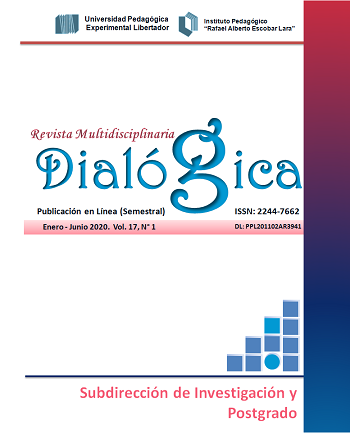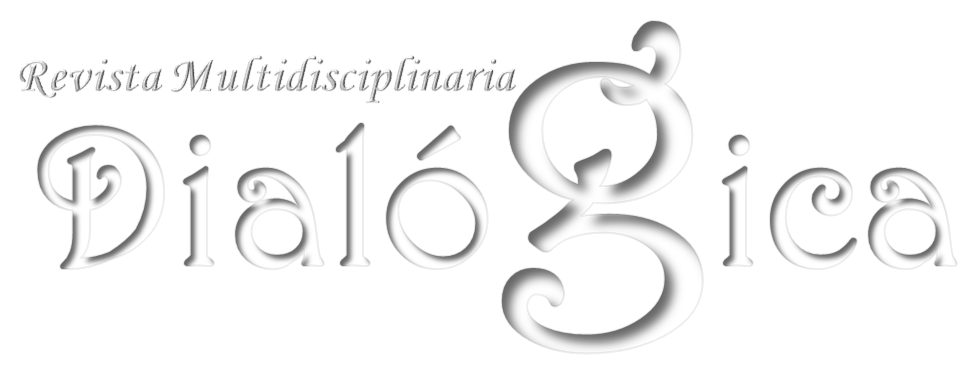Límite de una sucesión de números reales y límite de las funciones reales de una variable real: análisis de contenido
DOI:
https://doi.org/10.56219/dialgica.v17i1.1208Palabras clave:
Límite de Sucesiones de Números Reales, Límite de Funciones Reales de una Variable Real, Análisis de ContenidoResumen
La presente investigación tiene como propósito realizar el análisis de contenido del tópico matemático Límite, tanto de sucesiones de números reales como de funciones reales de una variable real. Este análisis de contenido se llevó a cabo con la noción que plantea Rico (2013), la cual distingue tres tipos de significados: la estructura, los sistemas de representación y los fenómenos asociados. En primer lugar se describirán los sistemas de representación de la noción de límite y luego los fenómenos asociados presentes en 15 libros de texto universitarios impresos. Esta investigación se encuentra inmersa en el
paradigma post-positivista, enfoque cualitativo, se empleó el método hermenéutico para interpretar las concepciones de tres estudiantes de la especialidad de Matemática de la UPEL – Maracay en cuanto al aprendizaje de los límites, reflejadas en las entrevistas. Como resultado se devela la estructura de los límites.
Citas
Andonegui, M, y Hernández, J. (2003). Concepciones acerca de la noción de límite. Disponible: https://www.clame.org.mx/actas1.html Consulta: 2019, Enero 7.
Ayres, F. (1971). Cálculo diferencial e integral. México: McGraw – Hill.
Azcárate, C y Camacho, M. (2003). Sobre la investigación en didáctica del análisis matemático. Disponible: http://www.emis.de/journals/BAMV/conten/vol10/matias-carmen.pdf Consulta: 2019, Enero 7.
Baranenkov, G., Demidovich, B., Efimenko, V., Frolov, S., Kogan, S., Lunts, G., Porshneva, E., Shostak, R., Sichova, E. y Yampolski, A. (1977). Problemas y ejercicios de análisis matemático. Moscú: MIR.
Barcellos, A y Stein, S. (1995). Cálculo y Geometría Analítica. Santafé de Bogotá: McGraw – Hill Interamericana.
Barragán, F, Pantoja, H y Sarabia, J. (1992). Problemas de Cálculo Diferencial. Barquisimeto: Elipse.
Bonilla, M. (2009). Análisis epistemológico de la noción de límite en un contexto computacional. Disponible: https://www.clame.org.mx/actas.html Consulta: 2019, Enero 4
Braschi, G. (2000). Matemática II. Barinas: Universidad Ezequiel Zamora.
Buitrago, O. y Macana, B. (1999). Matemática II. Barinas: Universidad Ezequiel Zamora.
Camacho, N., Díaz, M., Locia, E., Navarro, C. (2009). Formación del concepto de límite mediante dos registros de representación: representaciones gráficas y el uso algebraico. Disponible: https://www.clame.org.mx/actas.html Consulta: 2019, Enero 6.
Claros, F., Coriat, M. y Sánchez, M. (2007). Fenómenos que organizan el límite Disponible: https://www.google.com/url?sa=t&rct=j&q=&esrc=s&source=web&cd=&cad=rja&uact=8&ved=2ahUKEwictdHxiuPvAhUFSN8KHScIBpIQFjAAegQIAhAD&url=https%3A%2F%2Frevistaseug.ugr.es%2Findex.php%2Fpna%2Farticle%2Fdownload%2F6210%2F5525%2F&usg=AOvVaw3RilVRMdxLmuOmO3LhnbZL Consulta: 2019, Febrero 25.
Cruz, J y Ramírez, J. (2009). El entorno de aprendizaje dinámico modular orientado a objetos en la enseñanza del concepto de límite. Disponible: https://www.clame.org.mx/actas.html Consulta: 2019, Enero 4.(
De Guber, R. y Sadosky, M. (1975). Elementos de cálculo diferencial e integral. Buenos Aires: Alsina.
Edwards, B., Hostetler, R. y Larson, R. (2006). Cálculo. México: McGraw – Hill.
Edwards, C. y Penney, D. (1997). Cálculo diferencial e integral. México: Prentice – Hall Hispanoamericana.
Escobar, B. (1998). Matemática I. Funciones y Representaciones Gráficas. Caracas: Universidad Nacional Abierta.
Leithold, L. (1998). El Cálculo. México: Oxford University Press.
Maldonado, E., Miranda, N. y Navarro, C. (2007). Conflictos cognitivos que emergen en la resolución de problemas relativos al límite. Disponible: https://www.clame.org.mx/actas.html Consulta: 2019, Enero 7.
Martins, F, y Palella, S. (2010).Metodología de la Investigación Cuantitativa. Caracas: Fondo Editorial de la Universidad Pedagógica Experimental Libertador.
Mérida, K. (2003). El libro dinámico de CEUs. Límites y continuidad I. Maracay: Autor.
Purcell, E., Rigdon, S. y Varberg, D. (2001). Cálculo. México: Pearson.
Rico, L. (2013). El método del Análisis Didáctico. Disponible: www.fisem.org/www/union/revistas/2013/33/ARCHIVO6.pdf Consulta: 2019, Febrero 25.
Rico, L. y Segovia, I. (2001). Unidades Didácticas. Organizadores. Didáctica de la Matemática en la Escuela Primaria. Madrid: Síntesis.
Rojas, J. (1976). Cálculo I. Maracay: Autor.
Rojas, J. y Salazar, J. (1985). Matemática I Operaciones en N, Divisibilidad, Funciones. Caracas: Universidad Pedagógica Experimental Libertador.
Sáenz, J. (2005). Cálculo diferencial con funciones trascendentes tempranas para ciencias e ingeniería. Barquisimeto: Hipotenusa.
Stewart, J. (2001). Cálculo de una variable. Trascendentes tempranas. México: Thomson Learning.


 @revistadialogica
@revistadialogica DialogicaUPEL
DialogicaUPEL RevistaDialogicaUPELMaracay
RevistaDialogicaUPELMaracay dialógicaupel@gmail.com
dialógicaupel@gmail.com dialogicaupel.blogspot.com
dialogicaupel.blogspot.com https://issuu.com/dialogicaupel
https://issuu.com/dialogicaupel https://revistas.upel.edu.ve/index.php/dialogica/
https://revistas.upel.edu.ve/index.php/dialogica/










